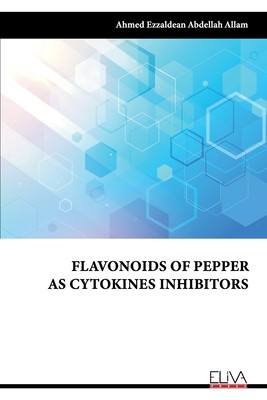
- We will send in 10–14 business days.
- Author: Ahmed Ezzaldean Abdellah Allam
- Publisher: Eliva Press
- Year: 2021
- Pages: 42
- ISBN-10: 1636481825
- ISBN-13: 9781636481821
- Format: 15.2 x 22.9 x 0.2 cm, softcover
- Language: English
- SAVE -10% with code: EXTRA
Flavonoids of Pepper as Cytokines Inhibitors (e-book) (used book) | bookbook.eu
Reviews
Description
Various naturally occurring phytochemicals exhibit anti-inflammatory activity and are considered to be potential drug candidates against inflammation-related pathological processes. Here, new flavonoid glycoside, kaempferol 3-O-α-¬[(6-P coumaroyl galactopyranosyl-O-β- (1→4)-O-α-rhamnopyranosyl-(1→4)]-O-α-rhamnopyranoside 1, in addition to five known flavonoid glycosides (2-6) kaempferol 3-O-[α- ¬rhamnopyranosyl-(1→4)-O-α-rhamnopyranosyl-(1→6)-O]-β- galactopyranoside (kaempferol 3-O-β-isorhamninoside) 2, quercetin 3-O- [(2,3,4-triacetyl-α-rhamnopyranosyl)-(1→6)-β-galactopyranoside 3, quercetin 3-O-[(2,4-diacetyl-α-rhamnopyranosyl)-(1→6)]-3,4-diacetyl-β- galactopyranoside 4, quercetin 3-O-[(2,4-diacetyl-α-rhamnopyranosyl)- (1→6)]-2,4-diacetyl-β-galactopyranoside 5, quercetin 3-O-[(2,3,4-triacetyl- α-rhamnopyranosyl)-(1→6)-3-acetyl-β-galactopyranoside 6 were isolated from bell pepper (Capsicum annum L.) fruits and tested for both antiinflammatory activity through cytokine production (TNF-α and IL-1β) and antioxidant activity through scavenging effect on 1,1-diphenyl-2- picrylhydrazyl (DPPH) assay. Compounds 1-3 significantly suppressed production of TNF-α / IL-1β in cultured THP-1 cells previously costimulated by LPS in a dose-dependent manner (10.2/49.1, 28.1/55.7, and 35.2/57.5 μM respectively) whereas compounds 4-6 have relatively weaker inhibitory activity. (45.3/73.5, 48.2/65.6, and 42.2/67.4 μM respectively). All compounds 1-6 showed no cytotoxic activity against the growth of THP-1where the percentage of cell viability was (127.4, 108.5, 105.4, 103.9, 103.4, and 104.2 μM respectively). All isolated compounds exhibited higher radical scavenging activity than ascorbic acid in (DPPH) assay. These results indicated that bell pepper fruits could be an effective candidate for ameliorating inflammatory-associated complications.
EXTRA 10 % discount with code: EXTRA
The promotion ends in 20d.14:28:19
The discount code is valid when purchasing from 10 €. Discounts do not stack.
- Author: Ahmed Ezzaldean Abdellah Allam
- Publisher: Eliva Press
- Year: 2021
- Pages: 42
- ISBN-10: 1636481825
- ISBN-13: 9781636481821
- Format: 15.2 x 22.9 x 0.2 cm, softcover
- Language: English English
Various naturally occurring phytochemicals exhibit anti-inflammatory activity and are considered to be potential drug candidates against inflammation-related pathological processes. Here, new flavonoid glycoside, kaempferol 3-O-α-¬[(6-P coumaroyl galactopyranosyl-O-β- (1→4)-O-α-rhamnopyranosyl-(1→4)]-O-α-rhamnopyranoside 1, in addition to five known flavonoid glycosides (2-6) kaempferol 3-O-[α- ¬rhamnopyranosyl-(1→4)-O-α-rhamnopyranosyl-(1→6)-O]-β- galactopyranoside (kaempferol 3-O-β-isorhamninoside) 2, quercetin 3-O- [(2,3,4-triacetyl-α-rhamnopyranosyl)-(1→6)-β-galactopyranoside 3, quercetin 3-O-[(2,4-diacetyl-α-rhamnopyranosyl)-(1→6)]-3,4-diacetyl-β- galactopyranoside 4, quercetin 3-O-[(2,4-diacetyl-α-rhamnopyranosyl)- (1→6)]-2,4-diacetyl-β-galactopyranoside 5, quercetin 3-O-[(2,3,4-triacetyl- α-rhamnopyranosyl)-(1→6)-3-acetyl-β-galactopyranoside 6 were isolated from bell pepper (Capsicum annum L.) fruits and tested for both antiinflammatory activity through cytokine production (TNF-α and IL-1β) and antioxidant activity through scavenging effect on 1,1-diphenyl-2- picrylhydrazyl (DPPH) assay. Compounds 1-3 significantly suppressed production of TNF-α / IL-1β in cultured THP-1 cells previously costimulated by LPS in a dose-dependent manner (10.2/49.1, 28.1/55.7, and 35.2/57.5 μM respectively) whereas compounds 4-6 have relatively weaker inhibitory activity. (45.3/73.5, 48.2/65.6, and 42.2/67.4 μM respectively). All compounds 1-6 showed no cytotoxic activity against the growth of THP-1where the percentage of cell viability was (127.4, 108.5, 105.4, 103.9, 103.4, and 104.2 μM respectively). All isolated compounds exhibited higher radical scavenging activity than ascorbic acid in (DPPH) assay. These results indicated that bell pepper fruits could be an effective candidate for ameliorating inflammatory-associated complications.


Reviews